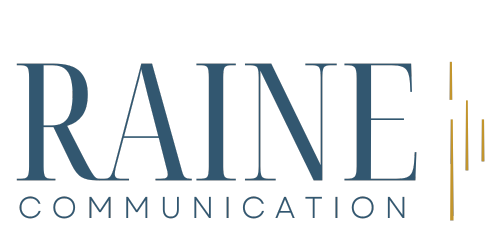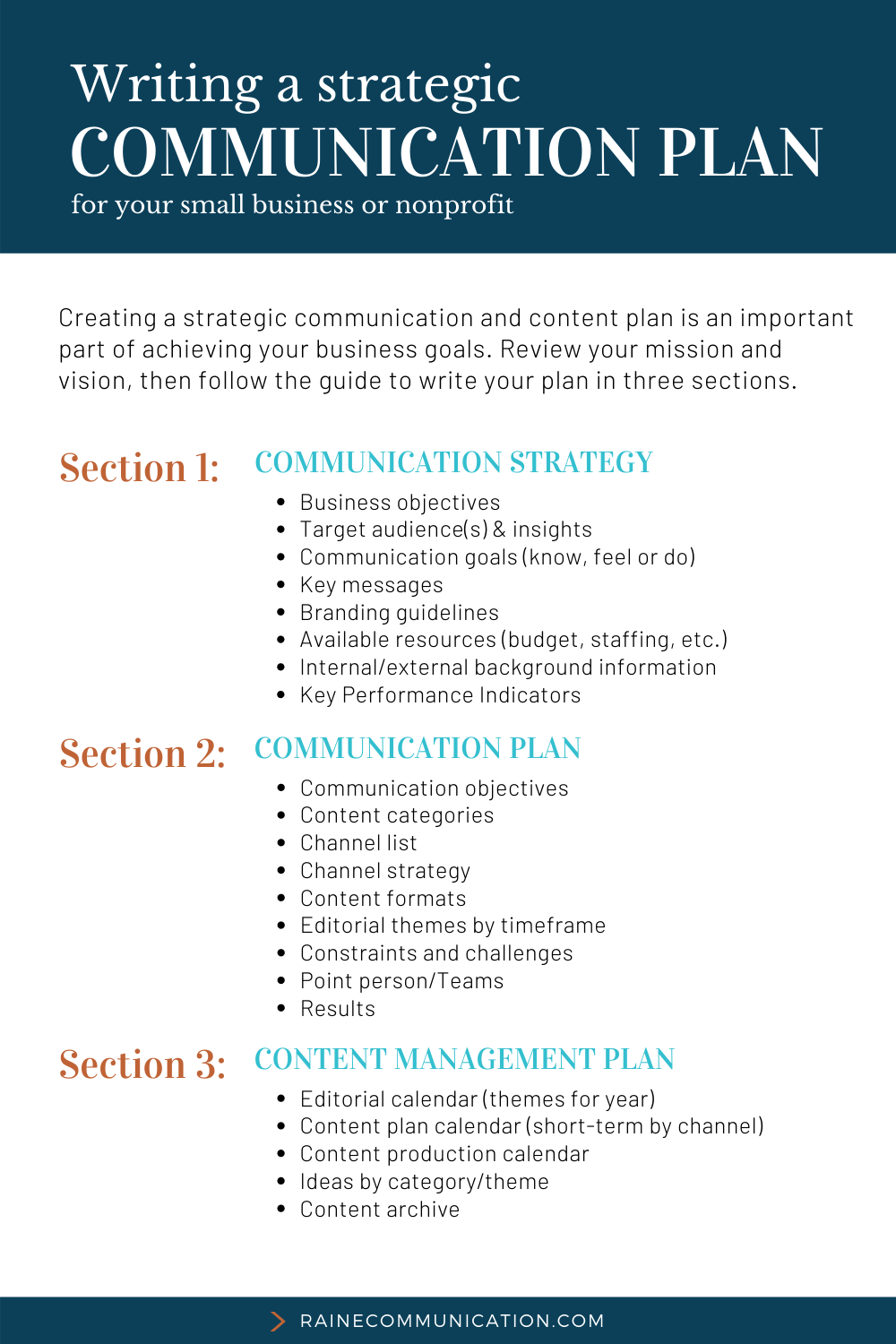A guide to writing a strategic communication and content plan
Whenever someone says, “I want to create [insert name of content here, like a video, a podcast, an article] about [insert topic here, like our work or our program] my first question is always:
Why?
The answer is usually along the lines of, “Because I want people to know about it.”
That’s fair. Of course they do. There are a lot of great programs and missions out there, and a lot of people doing the hard work of making the world a better place.
But I always like to ask the question of why because we can make great content all day, but without a plan in place guiding the content creation, as well as the communication of that content, organizations run the risk of making great content that hardly anyone ever sees or hears.
Or, they run the risk of making content that doesn’t make sense for their audience.
They also run the risk of making content that doesn’t do the work they intended, and therefore doesn’t maximize the time or money invested in creating it.
What they really want is for that content to help achieve a specific goal, which is likely something deeper than just knowing about a program. But without clarity around what the content should help achieve, there’s a real risk of not meeting the objective.
This is why it is so important to create a strategic communication plan before developing content.
A communication planning guide for small businesses and nonprofits
This post offers a guide to help small businesses and nonprofits create a strategic communication plan that will help manage content creation and communication and marketing outreach more effectively. I’ll share a three-section framework for you to try that drills down from overall strategy to individual content creation and distribution. I’ll cover what you need to do, why, and how, step-by-step.
You can use this guide as a starting point for creating your strategic communication plan. Once you have these pieces, you can tweak as needed based on your organization’s needs. Regardless of where you end up, the important part is that you get your plans written down and organized so that you can create more effective communications that achieve your goals, and save you time and money along the way.
Let’s connect on Instagram:
How to Set Up Your Strategic communication planning document
I am a proponent of as few management documents as possible to keep things simple, organized, and achievable. Especially for smaller teams and organizations, you don’t need a dozen different documents for managing your communication program. This framework consists of one overall planning document and one additional spreadsheet, which should be linked from the main document. A Word or PowerPoint document plus an Excel spreadsheet can be all you need for your strategic communication plan.
The main document has your overall thinking, and the linked spreadsheet becomes your living workbook for creating and managing your communications.
How to develop a strategic communication plan
Your Strategic Communication Plan will document what you communicate (and/or market), why, and how you’ll do it. You can break your plan into three sections:
Communication strategy – what you’ll do and why
Communication plan – how you’ll do it
Content management plan - how you will craft and manage content to support your plan
Open up a blank document on the other screen and let’s dive in to each section.
Section 1: Communication strategy
As stated above, strategy is all about what and why. What business result are you looking for? Why are you communicating with your audience? What’s the goal for your communications? Who is it for? What are you trying to achieve and why are you trying to achieve it?
A communication strategy is high-level, usually to support an organization’s business goals. Your communication strategy can have the following elements:
Business objectives (What specifically are you trying to achieve? Think SMART goals here.)
Target audience(s) & insights (based on experience and research)
Communication goals (what you want people to know, feel or do)
Key messages (based on a combination of target audience insights & communication goals)
Branding guidelines
Available resources (financial, staffing, etc.)
Internal/external background information (challenges, industry trends, relevant competitor information)
Key Performance Indicators (KPI - indications that you are reaching the goal)
You’ll likely have several audiences (donors, community members, volunteers, etc.), and your goals for each might vary. Here is an excellent guide to planning based on audience personas and how to create them.
Example:
You may decide in your communication strategy that you want to make sure more people in your community (audience) know about your organization’s events (communication goal), because you want to increase community involvement at your events by 5% (business objective). You know that many parents in your community like family-friendly events, so a key message might be that the event is kid-friendly. You might also include research for how people in your community get their information (audience insight) and new trends within your industry that might influence specific parts of your event (background information), and any budget or staffing considerations. A KPI might be that more people visit your event website.
Section 2: Communication plan
Your communication plan uses your strategic thinking to lay out how you’ll get from point A to point B. It gets into the tactics of how you’ll achieve your goals. This part should be reviewed on a regular basis.
A communication plan can include the following:
Communication objectives (specifically what you want to increase or decrease)
Overall categories of your communications/content (also known as pillars or buckets)
Channel list (include current best practices for each channel)
Channel strategy (specifics of how you’ll use each channel – see section below)
Content formats (what types of content do you need to create?)
High-level editorial themes over period of time (based on your pillars, organizational events, and research)
Constraints & challenges
Point person/teams
Results
Each of your chosen channels needs a strategy within your communication plan. A table or grid with channels across the top and the following list down the lefthand side should work well. Keep in mind that your website is a channel as well, and you need to manage it. Each channel should have:
Goals
Tools (such as your website platform or social media management tool)
Target audience
Audience-building strategies
Frequency of communication
Point person
Content types
Results
Placing each channel and it’s strategy in a grid will help you see how the content you create in one section can be utilized across other channels around the same time. You should start to see how you can maximize one piece of content in different ways to save you time (and therefore money).
Example, continued:
Your communication plan will consider how you’ll reach people in your community. You think about what your audience wants to know from you. Your research led you to believe your audiences like to receive emails and are active on Instagram and Facebook. You decide that you’ll become active on those channels because managing those channels seems achievable for your organization – you think you can actually keep up with regularly engaging on those communication channels (this is just as important as the channels your audience uses).
In the channel grid section, you create a column labeled “Email” and list details how you’ll go about your email program. Each row will includes the information in the list above, laying out your email strategy row by row. You do the same for the “Instagram” column and the “Facebook” column as well. You have a website, so you add that column as well.
You know that you’ll want to create blog articles for your website, and you’ll use the blog content to populate a lot of your content for your emails and social media.
You know in certain months you’ll want to focus on certain topics, and you know the types of content you need to create for your channels from your channel grid work. You think about your big spring event, and note that as your editorial theme around that time. You consider that you do not have much photography of your events and programs, and decide to check into hiring a photographer. You make a note of that under “Constraints.” You set aside time on your calendar to regularly review and note how your channels are performing and how you are doing towards your objectives.
Finding this guide helpful? Pin it to Pinterest!
Section 3: Content Management Plan
To create information for your channels in order to connect with specific audiences and share the information you think your audience is interested in (based on your research in the communication strategy section), you need to create a content management plan. You will regularly work in this document.
Content is the information you share across your channels. It might be your blog articles, your images, your stories in your newsletter, your microblogs on social media, and more. Your channels are the delivery method, and your content is the main show. Your content supports your communication strategy.
Because it’s easier to create calendars and columned lists in another document format, such as excel or a content management platform, you may want to include a link within your strategic plan instead of trying to capture this information right in your main document. Each can be a tab in a spreadsheet.
To create your content management plan, you can consider creating the following sections in your spreadsheet:
Editorial calendar – this tab will illustrate your overall themes for a period of time, such as a year, and will note holidays and important dates for your organization. This gives a big-picture overview of what you’ll need to consider when you create your content plan and what content you need to think about developing. (You sketched this in your communication plan section, and are repeating it here.)
Content plan calendar – this is a date-based, short-term look at what you want to share across your platforms. It might only stretch for a few weeks. This tab is where you illustrate what content you’ll share, on what channel, and on what day.
You’ll take a look at your editorial calendar and note down the themes for the planning period, as well as important holidays and events. You’ll think about what information you should share with your audiences that are relevant to that time, based on your themes, holidays, and events (as well as your capacity). You’ll note what topics you’ll cover on what channel and in what format (a relevant quote from your blog along with a link for your Facebook channel, for example). Your content plan will be flexible and updated regularly, in advance of the time period it covers.
Here’s what it can include:
Calendar/date view + important dates/events noted (along one axis)
Channels (along the other axis)
Upcoming topics/formats based on communication plan, per channel and date
Content production calendar – this tab is a view of specifically what’s being produced based on your content plan, when it’s set to be complete, and who is creating it, as well as any terms you want to include (for SEO). It might help to group related content in the same section. For example, if you are creating a blog post, you might need a summary to include in an email. You’ll want to add the summary as a line item related to the main content.
Here’s what it can include across the top:
Content title
Format
Target audience
Keywords
Channel
Due date
Point person/contractor
Logistical needs (e.g., interviewee, location for video shoot)
Ideas by category – this tab is your list of ideas for any future content creation. Keeping an idea list within your content management plan can be helpful when you are planning upcoming content. SEO and keyword research might help with generating ideas.
Content archive – This is a list of what you’ve created in the past and where those assets are stored. This is an important part of communication planning because you’ll want to get as much mileage out of one piece of content as possible. For example, one blog post, especially an evergreen post like a how-to, can be used and reused over time. When you’re thinking about what content you need to share, you’ll want to consider what you’ve already created on that topic and whether you can use that content.
Here’s what it can include:
Format
Title
Published date
Topic
Storage location/link
Results
Hootsuite shares some great examples for how to set up social media and content calendars that might be helpful.
Example:
Let’s consider the content management plan through our example. It’s March and you are planning April’s content. You noted in your Editorial calendar that you wanted to highlight your event in April. You think about topics around that event for your content plan.
A key message is that the event is kid-friendly, so you know that can be an area of focus. You decide that a story about a family who went to the event and loved it might encourage others to attend. You’ll know you need to find photos, do an interview, and write a story. You note this down in your production calendar and assign someone (or a team or contractor) to work on it. In April, you share this content across your channels on the specified date. Later, you look at how the story performed and note it in your content archive.
Planning needs for specific pieces of content
And finally, for individual pieces of content (and especially for larger content projects like a nonprofit podcast episode or audio show) like those listed in your production calendar, you’ll want to create project plans and schedules. These won’t be a part of your strategic document, but I want to note the importance of planning these pieces. You’ll want to note any strategic considerations and schedule out all the elements of content creation, from the project brief to interviews to editing to publishing. This will help ensure it gets done on time.
Final thoughts on developing a communication PLAN
Now you have a guide for creating your strategic communication plan in three sections, in no more than a couple of documents, to make management of your communications and content a little more straightforward.
I’ve covered a lot in this post. But as you can see, having a strategy and a plan behind your communications and content is a critical part of management, and you should do those steps before creating your content.
A good strategic communication plan like the one you can create using this guide will save time and money. You’ll think about what it is you should really be communicating and where, the needs of your audience, and how your content works by channel. You’ll see how content can be used in multiple ways across multiple channels. You’ll know exactly what you need to create for every topic and for each channel.
I realize this sounds like a lot of work. And it is, at first. But it’s important, foundational work. Strategy and planning ensure you create communications, like articles, podcasts, videos, and more, that resonate with your target audience. It helps ensure that your target audience will actually receive your messages through one of your channels. And, it helps you manage your work more effectively and efficiently so you can focus more time on fulfilling your mission.
(This post was edited from its original version. Read more about why you need a strategic communication plan, which was originally published as part of this post.)
Comments or questions? Please DM me on social media.
For more of my communications and content, subscribe to my biweekly emails and follow me on social media.
Photo at top by Jamie Street on Unsplash










